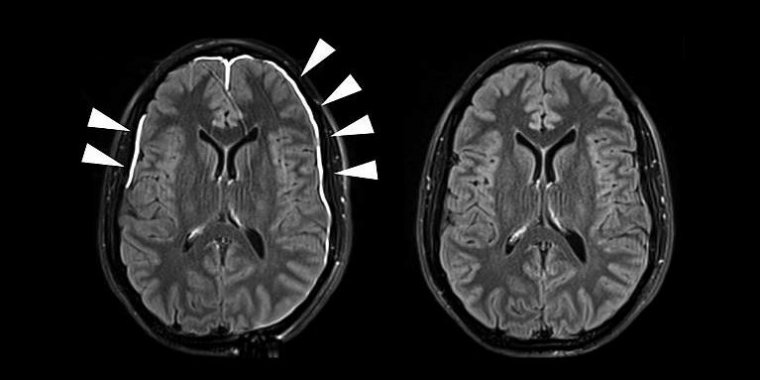| News / Science News |
Scientists watch the brain’s lining heal after a head injury
Following head injury, the protective lining that surrounds the brain may get a little help from its friends: immune cells that spring into action to assist with repairs.

One day after head injury (left), bright dye along the edge of the brain suggests damage to the meninges, or the brain’s protective lining. After 35 days (right), the dye no longer appears, indicating the meninges may have healed. Image credit: Larry Latour, Ph.D., NINDS
In a new study, scientists from the National Institutes of Health watched in real-time as different immune cells took on carefully timed jobs to fix the damaged lining of the brain, also known as meninges, in mice.
These results may help provide clues to the discovery that the meninges in humans may heal following mild traumatic brain injury (mTBI) and why additional hits to the head can be so devastating.
The meninges are a collection of membranes that line the central nervous system and help protect brain and spinal cord tissue from various forms of injury. Damage to the meninges can cause cell death in underlying brain tissue.
The team found that while most patients had repaired their leaky blood vessels within 20 days, 17 percent of patients still showed leakage on their MRI scans three months after injury, indicating ongoing meningeal damage and incomplete recovery.
Within the first day of injury, immune cells from the blood called inflammatory monocytes entered the core of the injured meningeal tissue and started clearing away dead cells.
These cells were assisted a few days later by a different type of blood monocyte that worked around the lesion edge to help rebuild damaged blood vessels, which were completely restored and fully functional within a week.
The team found that the actions of these different immune cell types did not overlap and that blocking the activity of one did not cause the other to take over.
The researchers also found that the timing of a second head injury has a significant impact on the repair process in mice. A second injury experienced within one day of the first TBI led to additional inflammation and the wound healing phase of repair, during which blood vessels are fixed, did not occur.
However, if the re-injury occurred after a few days, once the wound healing phase had already begun, there was no effect on the meningeal repair process and blood vessels were rebuilt normally.
The timing of a second head injury may determine whether the meninges can be repaired. Two or more head injuries within a very short amount of time can have really dire consequences for the brain lining and its ability to repair.
It is possible that patients who did not fully recover following a head injury may have had problems with the first phase of the repair process. (National Institutes of Health)
YOU MAY ALSO LIKE




